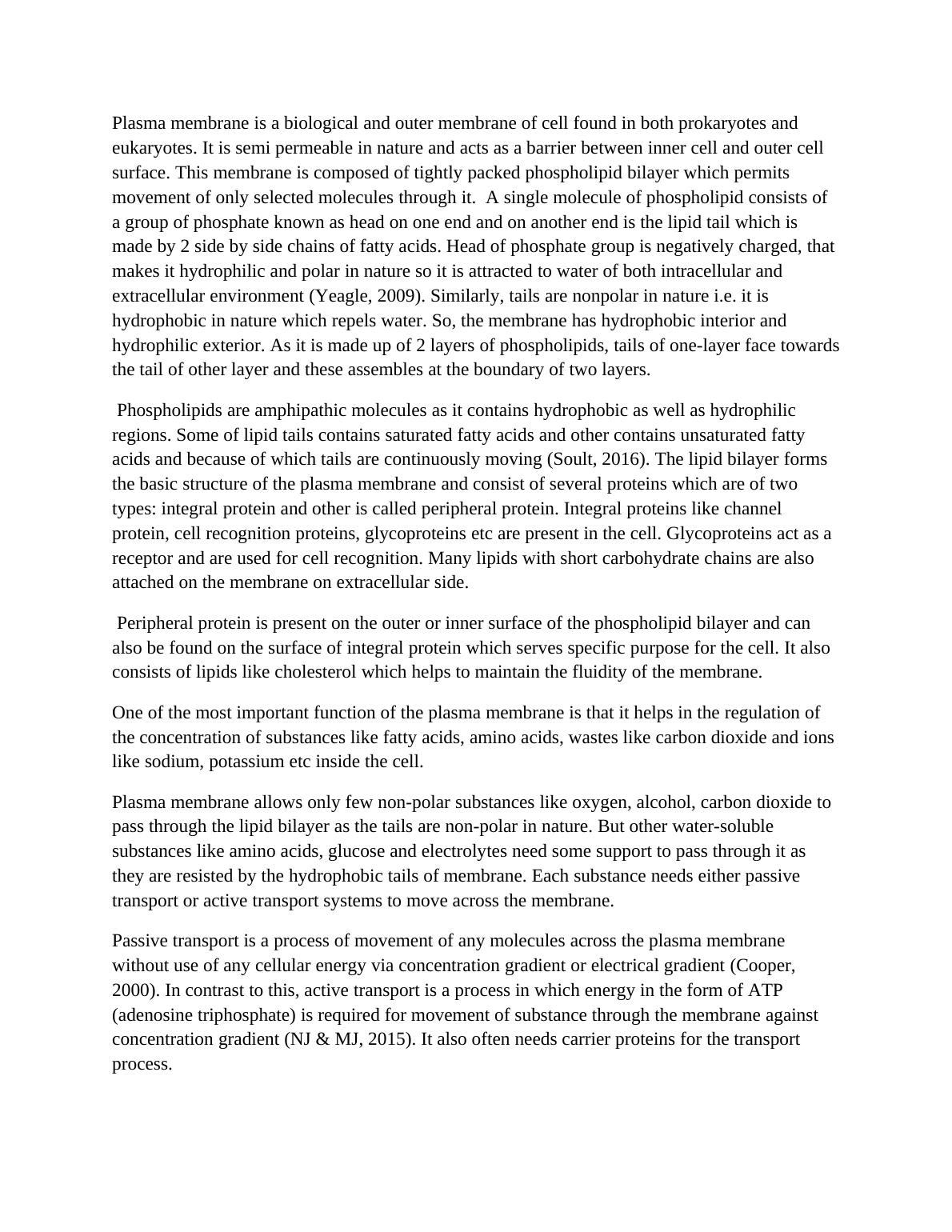(PDF) The Plasma Membrane and the Cell Wall
Added on 2021-04-17
3 Pages1062 Words121 Views
Plasma membrane is a biological and outer membrane of cell found in both prokaryotes and eukaryotes. It is semi permeable in nature and acts as a barrier between inner cell and outer cell surface. This membrane is composed of tightly packed phospholipid bilayer which permits movement of only selected molecules through it. A single molecule of phospholipid consists of a group of phosphate known as head on one end and on another end is the lipid tail which is made by 2 side by side chains of fatty acids. Head of phosphate group is negatively charged, that makes it hydrophilic and polar in nature so it is attracted to water of both intracellular and extracellular environment[CITATION Yea09 \l 1033 ]. Similarly, tails are nonpolar in nature i.e. it is hydrophobic in nature which repels water. So, the membrane has hydrophobic interior and hydrophilic exterior. As it is made up of 2 layers of phospholipids, tails of one-layer face towardsthe tail of other layer and these assembles at the boundary of two layers. Phospholipids are amphipathic molecules as it contains hydrophobic as well as hydrophilic regions. Some of lipid tails contains saturated fatty acids and other contains unsaturated fatty acids and because of which tails are continuously moving[CITATION Sou16 \l 1033 ]. The lipid bilayer forms the basic structure of the plasma membrane and consist of several proteins which are of two types: integral protein and other is called peripheral protein. Integral proteins like channel protein, cell recognition proteins, glycoproteins etc are present in the cell. Glycoproteins act as a receptor and are used for cell recognition. Many lipids with short carbohydrate chains arealso attached on the membrane on extracellular side. Peripheral protein is present on the outer or inner surface of the phospholipid bilayer and can also be found on the surface of integral protein which serves specific purpose for the cell. It also consists of lipids like cholesterol which helps to maintain the fluidity of the membrane.One of the most important function of the plasma membrane is that it helps in the regulation of the concentration of substances like fatty acids, amino acids, wastes like carbon dioxide and ions like sodium, potassium etc inside the cell. Plasma membrane allows only few non-polar substances like oxygen, alcohol, carbon dioxide to pass through the lipid bilayer as the tails are non-polar in nature. But other water-soluble substances like amino acids, glucose and electrolytes need some support to pass through it as they are resisted by the hydrophobic tails of membrane. Each substance needs either passive transport or active transport systems to move across the membrane. Passive transport is a process of movement of any molecules across the plasma membrane without use of any cellular energy via concentration gradient or electrical gradient[CITATION Coo00 \l 1033 ]. In contrast to this, active transport is a process in which energy in the form of ATP (adenosine triphosphate) is required for movement of substance through the membrane against concentration gradient[CITATION Yan15 \l 1033 ]. It also often needs carrier proteins for thetransport process.

End of preview
Want to access all the pages? Upload your documents or become a member.
Related Documents
Plasma Membrane: Structure and Functionlg...
|4
|762
|388
Structure and Function of Hydrophilic Channellg...
|4
|616
|27
Surname 18. Name. Professor. Institution. Course. Date.lg...
|23
|3642
|7
Plasma Membrane - Assignmentlg...
|4
|550
|270
Anatomy and Transport Across Plasma Membranelg...
|4
|644
|419
Fluid Mosaic Model: Structure and Components of Cell Membranelg...
|23
|4299
|480
